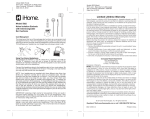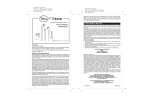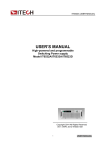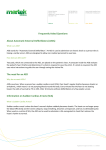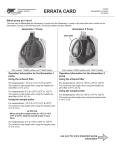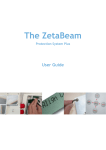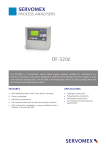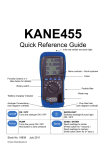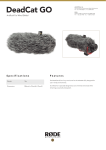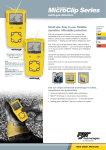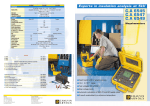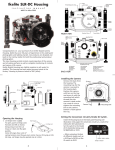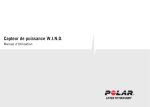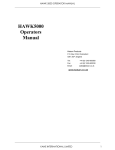Download RD99 REFRIGERANT GAS LEAK DETECTOR
Transcript
RD99 REFRIGERANT GAS LEAK DETECTOR WARNING! Turn the unit off and remove the battery before cleaning or replacing sensor. Failure to do so may result in mild electrical shock or damage to the instrument. Protection Against Electric Shock (in accordance with EN 61010-1 : 1993) This instrument is designated as Class III equipment and should only be connected to SELV circuits. 1 TABLE OF CONTENTS PRODUCT FEATURES .....................................3 GENERAL DESCRIPTION ...............................4 OPERATION.....................................................5-8 • BASIC OPERATION • LOW SENSITIVITY MODE • HIGH SENSITIVITY MODE • RESETTING ZERO EMC....................................................................8-9 BATTERY REPLACEMENT...........................10 SENSOR REPLACEMENT..............................11 SPECIFICATIONS............................................12 WARRANTY INFORMATION .......................13 APPENDIX .........................................................14 2 PRODUCT FEATURES 5 6 1 2 PWR 7 RD99 N L W HIGH O LOW \ O OFF O FF 3 H IG H LOW BAT 8 9 4 10 1. 2. 3. 4. 5. Protective boot Low battery indicator Power on light Audible leak indicator Advanced ionisation sensor 6. 7. 8. 9. 10. 3 Sensor protector Gooseneck clip LED array High/Low/OFF switch Flexible gooseneck GENERAL DESCRIPTION The RD99 is an advanced technology refrigerant gas leak detector. This detector is capable of locating any of the current halogen based gases such as refrigerants. These gases include CFCs, HCFCs and HFCs. A partial list of these gases include: CFCs - R11, R12, R13 etc HCFCs - R22, R502, R500 etc HFCs - R134A, R123, R125, R33 etc This unit will detect other halogen compounds such as SF6, Perchlorethylene and Halon. Please contact your distributor or Kane International Ltd for more information on a specific application. This instrument is not to be used in combustible environments. 4 OPERATION BASIC OPERATION 1. Turn the instrument ON by sliding the High/Low/OFF switch to either LOW or HIGH in a non-contaminated environment i.e. Fresh air 2. The power light will be illuminated green when the unit is turned on. If the batteries are too low to operate the instrument this light will be RED. 3. The instrument can be switched off at any time by moving the switch to OFF. It is advisable to turn off in fresh air. 4. If the tip of the sensor becomes wet shake off excess and allow to dry naturally. 5 LOW SENSITIVITY MODE With the switch set to LOW: 5. The LED array will cycle from green to yellow, and then red indicating the instrument is performing an auto-zero. 6. Once the auto-zero is complete the green LED will settle to a steady 2 second flash rate accompanied by a “bip”. This indicates the instrument is ready for use. 7. To pinpoint a leak source, move the sensor tip along the area to be checked. The tick rate will increase as you approach a leak and the green LED will flash faster. As concentration of gas increases the LED array will progressively move from flashing yellow, orange and red (highest). 8. The tick rate will decrease and the lights will go out when you move away from the leak source. 6 HIGH SENSITIVITY MODE To pinpoint the leak or find a very small leak: 9. Set the instrument to HIGH sensitivity using the slide switch, when switching from LOW to HIGH sensitivity the top red LED will flash once. 10. Operation is as in low sensitivity mode but is more sensitive to small changes in concentration. 11. Move the tip to levels of higher concentration indicated by an increase in tick rate and more lights on the LED array. If the LED array displays continuously flashing red, turn the switch to Low Sensitivity and continue. RESETTING ZERO 12. In fresh air the green LED should settle to a 2 second flash rate accompanied by a blip sound. 7 13. To reset zero in fresh air, turn off the unit for about 2 seconds then turn on in either LOW or HIGH sensitivity mode. ELECTROMAGNETIC COMPATIBILITY The European Council Directive 89/336/EEC requires that electronic equipment does not generate electromagnetic disturbances that exceed defined levels and has an adequate level of immunity to enable it to be operated as intended. The specific standards applicable to this product are detailed in the appendices. Since there are many electrical products in use that pre-date this Directive and may emit electromagnetic radiation in excess of the standards defined in the Directive there may be occasions where it would be appropriate to check the detector prior to use. The following procedure should be adopted: 8 Go through the normal start up sequence in the location where the equipment is to be used. Switch on all localised electrical equipment that might be capable of causing interference. Check that all readings are as expected. (A level of disturbance in the readings is acceptable). If not adjust the position of the instrument to minimise interference or switch off, if possible, the offending equipment for the duration of the test. At the time of writing this manual (Feb 1999) Kane International Ltd is not aware of any field based situation where such interference has ever occurred and this advice is only given to satisfy the requirements of the Directive. 9 BATTERY REPLACEMENT 1. Remove the battery cover on the back of the instrument. 2. Replace the 9 volt battery. A lithium or alkaline battery should always be used. Ensure the terminals on the battery are the correct polarity. 3. Replace the battery cover ensuring it is clicked home and locked in place. 10 SENSOR REPLACEMENT If the tick rate becomes uncontrollable, it may be necessary to change the sensor. We recommend that the sensor should be replaced at least once a year. To remove the sensor: 1. Turn the unit off and remove the battery. 2. Unscrew the sensor anti-clockwise from the gooseneck. 3. Replace with new sensor by turning the sensor clockwise until finger tight. WARNING! Turn the unit off and remove the battery before cleaning or replacing sensor. Failure to do so may result in mild electrical shock or damage to the instrument. 11 SPECIFICATIONS Power Supply: Sensor: Sensitivity: Indicators: Warm-up: Response Time: Duty Cycle: Battery Life: Dimensions: Weight: Probe Length: Ambient Conditions: One 9V PP3 battery Advanced ionisation detection 5 gms per year 134A based on LS-20 leak standard Audible: Auto-zero tick rate Visual: Flashing LED array <10 seconds <1 second Continuous Approx 8 hours 180mmH x 70mmW x 35mmD 400gms 400mm 0-40°C, 0-80% RH (noncondensing) Sensor-tip output voltage/current: A. B. C. No load high voltage 2500V+10% Current - 24µA Loaded high voltage (loaded with 100.1MΩ) 2400V+50V 12 WARRANTY All Kane International Limited instruments include batteries and carry a 12 month warranty, covering any manufacturing defects and component failures. This warranty applies to all Kane International Limited products world-wide. In line with our policy of continuous development we reserve the right to alter any part of our product specification without prior notice. 13 APPENDIX ELECTROMAGNETIC COMPATIBILITY This product has been tested for compliance with the following generic standards: EN 50081-1 EN 50082-1 and is certified to be compliant Specification EC/EMC/KI/RD99 details the specific test configuration, performance and conditions of use. 14 Thank you for reading this data sheet. For pricing or for further information, please contact us at our UK Office, using the details below. UK Office Keison Products, P.O. Box 2124, Chelmsford, Essex, CM1 3UP, England. Tel: +44 (0)1245 600560 Fax: +44 (0)1245 808399 Email: [email protected] Please note - Product designs and specifications are subject to change without notice. The user is responsible for determining the suitability of this product.


















